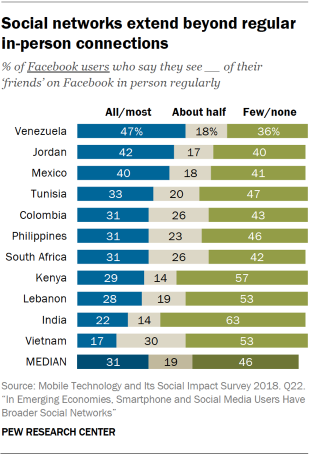 Social media platforms provide a major avenue for people to connect with friends, relatives and acquaintances they do not see in person on a regular basis. A median of 46% of Facebook users report seeing few or none of their Facebook “friends” in person regularly, while just 31% see most or all of them in person regularly. Venezuelans, Jordanians and Mexicans report the greatest overlap between their Facebook friends and those they see in person regularly: Four-in-ten or more Facebook users in each country see most or all of their Facebook friends in their day-to-day lives. But in every other country surveyed, pluralities or majorities of users see few or none of their Facebook friends in person regularly, including more than half of Kenyan, Lebanese, Indian and Vietnamese Facebook users.
Social media platforms provide a major avenue for people to connect with friends, relatives and acquaintances they do not see in person on a regular basis. A median of 46% of Facebook users report seeing few or none of their Facebook “friends” in person regularly, while just 31% see most or all of them in person regularly. Venezuelans, Jordanians and Mexicans report the greatest overlap between their Facebook friends and those they see in person regularly: Four-in-ten or more Facebook users in each country see most or all of their Facebook friends in their day-to-day lives. But in every other country surveyed, pluralities or majorities of users see few or none of their Facebook friends in person regularly, including more than half of Kenyan, Lebanese, Indian and Vietnamese Facebook users.
Communication is not as it used to be, as social networks are not social. You don’t see people in person.Woman, 35, Mexico
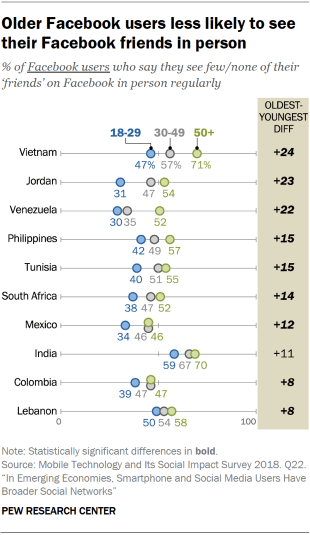 For older users, Facebook can be an especially important way to make connections beyond the people they see in person regularly. In nine of the 10 countries where there are enough older Facebook users to make comparisons, those ages 50 and older are more likely than younger users to report seeing only a few of their Facebook friends on a routine basis. In Jordan, for instance, 54% of Facebook users ages 50 and older say they see few or none of their Facebook friends in person regularly compared with 31% of users under 30. Gender and educational differences are much less pronounced – and in most countries, there is no significant difference at all.
For older users, Facebook can be an especially important way to make connections beyond the people they see in person regularly. In nine of the 10 countries where there are enough older Facebook users to make comparisons, those ages 50 and older are more likely than younger users to report seeing only a few of their Facebook friends on a routine basis. In Jordan, for instance, 54% of Facebook users ages 50 and older say they see few or none of their Facebook friends in person regularly compared with 31% of users under 30. Gender and educational differences are much less pronounced – and in most countries, there is no significant difference at all.
Interacting with people of different incomes is common in most countries surveyed
Across the 11 nations surveyed, larger shares say they regularly encounter people of different income levels than say they regularly encounter people of other races, religious persuasions or political affiliations. A median of 66% say they frequently or occasionally interact with people of other income levels, including majorities in nearly every country surveyed. And a median of around half or fewer regularly interact with people of different racial, religious or political backgrounds.
More than half of South Africans, Venezuelans, Colombians and Lebanese say they regularly interact with people who are different from them across each of the four traits asked about on the survey. Mexicans, by contrast, are less likely than people in other countries to say they regularly come across people different from them. For example, Mexico is the only country surveyed where fewer than half say they regularly interact with people of a different income level.
Majorities in many countries come across people who are different from them at least occasionally. But in no country – and for none of the four traits asked about – does a majority frequently come across people who are different from them in some way. While more people encounter others from different socioeconomic levels than encounter people from different races or religious persuasions, the share who frequently encounter people who are different from them across any of these traits peaks at 48% in Jordan.
Across other dimensions, even smaller shares say they frequently interact with people who are different from them. For instance, only 11% of Filipinos and 15% of Indians frequently interact with people who support different political parties than they do. And fewer than one-in-five in Jordan, Tunisia, the Philippines and Vietnam frequently interact with people who have religious views different from theirs. Indeed, in Jordan and Tunisia – two religiously homogeneous nations – about four-in-ten say they never come across people with religious views different from theirs, the highest shares of any country surveyed.
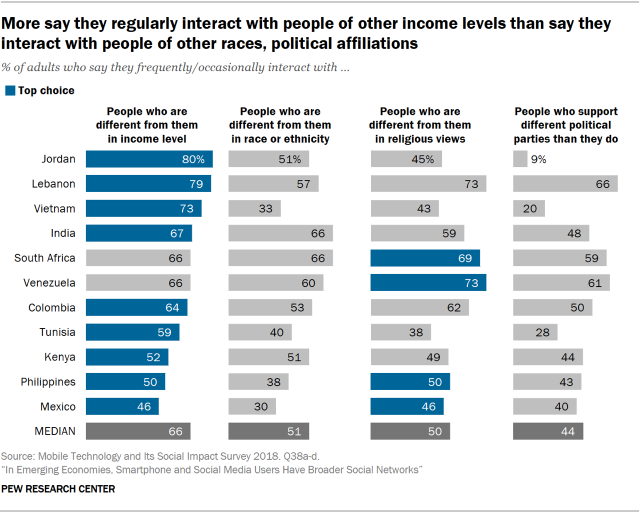
Social media users have more diverse personal networks
[Using social media] makes people get in touch and get connected with people from different cultures and different civilizations and different countries.Woman, 19, Tunisia
Social media and messaging app users are more likely to encounter people who are different from them across all the categories we queried – whether income, political party, religious views or ethnicity. Consider Colombia. Social media users in that country are more likely than non-users to interact with people who are different from them across each of the four traits surveyed. They are 23 percentage points more likely to regularly interact with people of another income level, 22 points more likely to interact with people who support other political parties, 19 points more likely to interact with people of other races or ethnicities and 17 points more likely to interact with people who have religious views different from theirs.
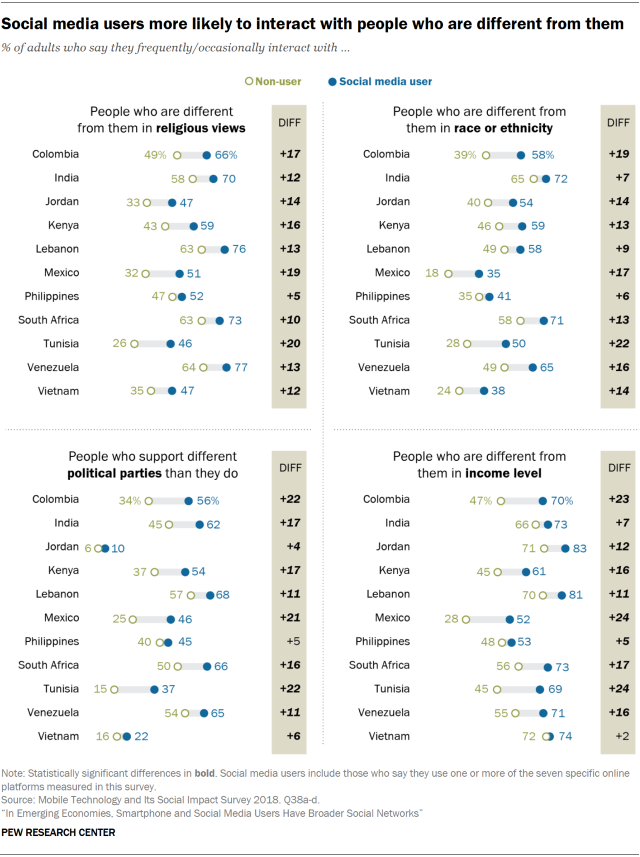
This pattern plays out in deeply divided contexts as well. In South Africa, social media users are 13 percentage points more likely to regularly interact with people of other races. And in Lebanon, a country with high religious diversity, social media users are 13 points more likely to regularly interact with people who have different religious views.
Smartphone users also stand apart from those who don’t use smartphones in the diversity of their personal networks. But these differences are due in part to the close relationship between social media use and smartphone use in most countries studied. Across most of the 11 emerging economies, people without phones and those with only basic or feature phones are equally likely to have interactions with those who are different from them.
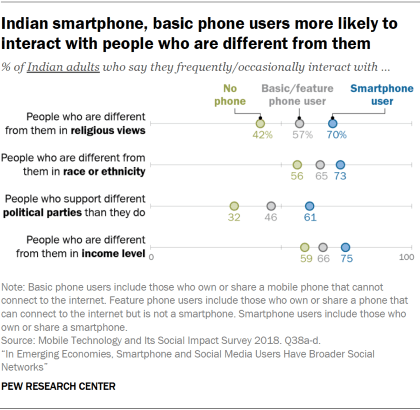 India – a country with relatively low mobile phone use – is a notable exception. Indians with phones are more likely to interact with people who are different from them across all of these dimensions than people without devices.5 For example, 42% of Indians without mobile phones say they regularly interact with people who have different religious views than they do, while a majority of those with basic phones or feature phones (57%) – and 70% of smartphone users – say the same.
India – a country with relatively low mobile phone use – is a notable exception. Indians with phones are more likely to interact with people who are different from them across all of these dimensions than people without devices.5 For example, 42% of Indians without mobile phones say they regularly interact with people who have different religious views than they do, while a majority of those with basic phones or feature phones (57%) – and 70% of smartphone users – say the same.
More generally, men, young people and those with at least a secondary education are more likely to encounter people who are different from them, regardless of the type of difference measured. For example, a majority of Kenyans with at least a secondary education say they regularly interact with people of different income levels (66%), ethnicities (58%), religious persuasions (62%) and political affiliations (57%). But Kenyans with lower levels of education are less likely to say they regularly interact with each of these groups – ranging from 39% who say they regularly interact with people who support different political parties to 48% who say the same of other racial groups. Similar patterns play out between men and women, as well as between those ages 18 to 29 and those 50 and older.


